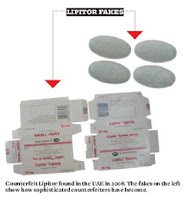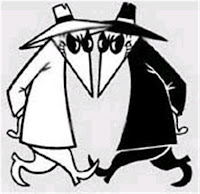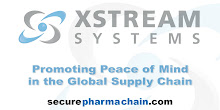20 Pfizer products are counterfeited worldwide with Lipitor, Norvasco and Viagra topping the list.The following is a news report that appeared in the Khaleej Times Online, regarding UAE’s efforts to combat faux pharmaceuticals and was authored by Sajila Saseendran and Emily Meredith (sajila@khaleejtimes.com) 15 February 2009. The plain white boxes with dull grey lettering that line pharmacy shelves are supposed to contain medicine to improve people’s well being. But worldwide concern over the legitimacy of pharmaceuticals has increased markedly in the last three years. At an open forum attended by representatives of the Ministry of Health and private sector on Thursday in Sharjah, a representative pharmaceutical company Pfizer, said there is still a threat in the Middle East despite recent initiatives to curb illicit trade in fake – and potentially harmful – medicines.
“There are lots of initiatives (being taken) against counterfeiting here. But we cannot say that Middle East region is free of fake medicines, especially because of the presence of many free trade zones here,” Steve Allen, Europe and MENA Senior Director of Global Security for Pfizer, said. “Just a year ago, we had found counterfeited Lipitor in the retail chain here.” The World Health Organisation’s International Medical Products Anti-Counterfeiting Taskforce (IMPACT) estimates that fake pharmaceuticals – medicines produced by unlicensed manufacturers and introduced directly into the global supply chain –make up one per cent of drug sales in developed countries and approximately 30 per cent in some countries in Asia, Africa and Latin America. A British investigation in January into how the anti-psychotic drug, Zyprexa, entered the national health system highlighted the problem. Some reports suggested that drugs may have found their way into the United Kingdom in shipments that originated in China and passed through UAE ports.

The UAE’s Role: Dubai sits at the nexus of several transit points. Goods from Africa and Asia bound for the rest of the world pass through the city’s ports at a fast pace. This pace – approximately six hours for sea cargo to be checked, driven through Dubai’s roads and put on an outbound plane – appeals to people trying to ship illicit goods, according to Mohammad Al Mari, head of the Intellectual Property Rights Section of Dubai Customs.
“It’s not the location, it’s the infrastructure we have developed,” he said. Al Mari said he liked the pace, especially just a few years ago when the sea to air transfer time was one-third of today’s.” “It used to be fun, but not anymore with the traffic,” Al Mari said, smiling. But the speed is also the reason for his concerns. It has “given people the impression of using an easier, proper supply chain.”
Health and Customs officials in the UAE say they are working to counteract this impression with a set of new initiatives that include a national committee on counterfeit drugs established in January, portable devices for use at entry points to detect drugs and a proposal to increase the number of drug inspectors. The chair of the new national committee and the CEO of Medical Practice and Licence at the Ministry of Health, Dr. Amin Al Amiri, said the committee will extend its reach beyond the pharmaceuticals used to treat chronic conditions like diabetes, hypertension and cardiovascular diseases preferred by counterfeiters to medical devices and food supplements. “It is not just the fake medicines that pose a threat to public health. We need to prevent fake medical devices and food supplements, too,” Al Amiri said. “That is why the committee wants to monitor the import and export of medical devices and food supplements as well.”
The Ministry of Health requires all companies importing prescription, non-prescription and veterinary medicines to obtain a permit and send a copy to the Customs officials. Companies using the UAE’s ports to move these products also have to register. Al Amiri said the Ministry of Health (MoH) last month mandated pre-registration for food supplements and medical devices. “We have stringent procedures for registrations. Manufacturing companies have to produce a lot of certificates,” he said. Customs officials do not typically release medical shipments from port entry points until a trained pharmacist from MoH checks the shipment.
Al Mari said 70-80 per cent of the drugs entering Dubai’s ports are sampled and sent for testing at MoH’s drug control lab in Abu Dhabi. To ensure that the other cargo does not contain illicit imports, Al Mari said Dubai Customs fully offloads and inspects five to seven per cent of all cargo passing through the emirate. Twelve per cent of shipments are scanned. At certain spots, there are tougher regulations. At the dhow site for sea cargo, 100 per cent of all vessels are inspected. Al Amiri said companies have been given a grace period of six months to register their products. From June, shipments with unregistered drugs, devices and supplements will not be allowed entry in the UAE. “As of now, we are releasing the shipment, but we will not allow it go to the market unless the company registers the products within six months. It is for the protection of the community and to have best quality products in the country. We don’t want anything to enter the country unless it is registered and regulated.” The threat at home: Al Amiri said it was difficult to quantify the threat posed by counterfeit pharmaceuticals. “We don’t have a figure for the UAE. But we presume the threat of counterfeiting of mainly the drugs for chronic diseases, such as diabetes and hypertension, because of their wide use, and some other expensive pills,” he said. “We have never detected anything that is very dangerous or lethal. So far, a few of the drugs related to hypertension have been confiscated.” In 2008, Dubai Customs found only one instance of fake product: counterfeit hand cream. Recently, the UAE changed several policies in an effort to protect local residents. If inspectors suspect any item to be fake, it will be immediately reported to the police and sent to the drug inspection section for investigation. Non-registered drugs, once confiscated here, have to be sent back to the country of origin. “We have introduced this new system,” Al Amiri said. “We don’t allow any unwanted drugs to be destroyed here in our land. We don’t want any adverse impact to our environment and public health due to this.”
The UAE has also banned drug repackaging, once done on Emirati soil. “Some companies used to bring some of the non-registered drugs, repack it here and export it to some other countries. When they confiscate these, they think that all those drugs went from here which resulted in negative reputation to the UAE. We have stopped that practice and strictly banned the repackaging of medicines.”
Steve Allen from Pfizer said drug counterfeiting should be punishable more severely than in IPR violations because of the damages they cause. “It is not just about piracy like in the case of counterfeit CDs. Fake medicines can kill people and their trade is an organised crime,” Allen pointed out.
Private investigators employed by big pharmaceutical companies like Pfizer alert regulatory bodies about the entry of fake medicines into the market and any breach in the supply chain. “We would like the Customs to have the same level of focus on counterfeit medicines as on narcotics. Narcotic drug addicts know what they are taking and its potential dangers,” he said. “But it’s innocent patients whose health is affected because of counterfeit prescription drugs. Some can be lethal. We have found rat poison, boric acid and inkjet cartridges in some fake drugs.” About 20 Pfizer products are counterfeited worldwide with Lipitor, Norvasco and Viagra topping the list. Allen said counterfeiters were shifting focus to life-saving from lifestyle medicines because of expected delays in response. Anwar Hussain, assistant manager for purchases and R &D with the Medshop pharmacy chain, presented a paper on health hazards of fake drugs at Thursday’s forum. He called on pharmacists to buy medicines from authorised agents. “Pharmacists should ensure that all products are supplied against valid invoices stating the batch numbers. They should watch out for the products offered at high bonuses or extra discounts by unauthorised suppliers, monitor warnings from manufacturers and look out for pricing labels approved by the MoH.”





















